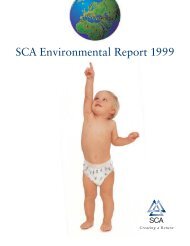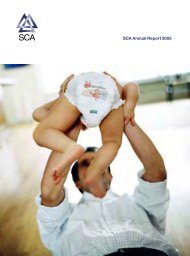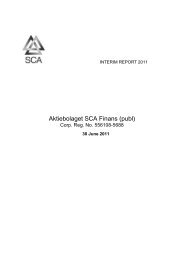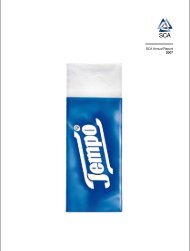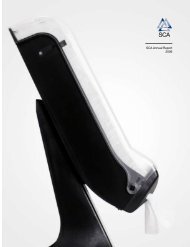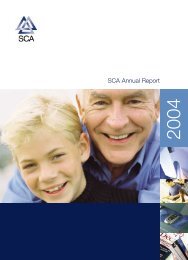Annual Report 1998
Annual Report 1998
Annual Report 1998
You also want an ePaper? Increase the reach of your titles
YUMPU automatically turns print PDFs into web optimized ePapers that Google loves.
42<br />
industry companies in North America and Finland are major<br />
exporters.<br />
Group euro cash-pool structure<br />
During the first quarter of 1999, a comprehensive cash-pool<br />
structure will be introduced for Group euro-currency transactions.<br />
This will reduce the number of international payments,<br />
thus minimizing float periods and transaction costs. Cash<br />
management will also be more efficient, since euro liquidity on<br />
a day-to-day basis will be concentrated in a single account.<br />
INTEREST-RATE RISKS<br />
Interest-rate fluctuations have a direct impact on SCA’s consolidated<br />
earnings due to changes in net interest, but there is<br />
also an indirect effect as a result of the impact of interest levels<br />
on the economy as a whole. SCA’s policy is to maintain a short<br />
fixed interest term, since the company considers that this results<br />
in lower borrowing costs and a more stable earnings trend<br />
in the long run.<br />
Management of the Group’s interest-rate exposure is a centralized<br />
function. SCA Finans is responsible for identifying and<br />
managing this exposure. During <strong>1998</strong>, the average fixed-interest<br />
term was approximately seven months. At year-end the<br />
fixed-interest term was slightly less than six months.<br />
REFINANCING RISKS AND LIQUIDITY<br />
At 31 December <strong>1998</strong>, gross debt amounted to SEK 25,806 M.<br />
After deduction for liquid funds, interest-bearing receivables<br />
and capital investment shares, net debt was SEK 21,370 M.<br />
Liquidity risk is defined as the risk of being unable to meet<br />
payment obligations as a result of inadequate liquidity or difficulties<br />
in obtaining credit from external sources.<br />
SCA applies a centralized approach to management of<br />
Group financing. SCA Finans is responsible for external borrowing<br />
and external investment.<br />
The aim is that liquid funds and committed credit facilities<br />
should amount to at least 10% of forecast annual sales for the<br />
Redemption structure for<br />
interest-bearing debt<br />
Year SEK M<br />
1999 6,629<br />
2000 1,128<br />
2001 3,987<br />
2002 6,803<br />
2003 6,580<br />
2004– 679<br />
Total 25,806<br />
The average maturity period at year-end was 3 years.<br />
Group, and that the average maturity for the Group’s gross<br />
debt should be in excess of three years.<br />
At year-end, the average maturity was three years. Liquid<br />
funds and unutilized committed credit facilities amounted to<br />
SEK 9,403 M at year-end, which corresponded to 15% of<br />
Group sales in <strong>1998</strong>.<br />
During <strong>1998</strong>, the existing SEK 4,000 M in committed credit<br />
facilities was refinanced by means of a number of bilateral<br />
transactions. In this connection, the total amount was increased<br />
to SEK 6,000 M, and the average maturity period was<br />
prolonged. The counterparties for these credit facilities are<br />
eight international banks of high repute.<br />
During the year, framework for SCA Finans’ Swedish commercial<br />
paper program was increased from SEK 4,000 M to<br />
SEK 8,000 M.<br />
In order to reduce the costs of finance for working capital in<br />
SCA’s Polish operations, a Polish commercial paper program<br />
was arranged, with a framework totaling PLN 100 M (SEK<br />
220 M).<br />
A Swedish Medium Term Note (MTN) program was<br />
established during <strong>1998</strong> in order to diversify the Group’s<br />
medium and long-term credit facilities. The MTN program,<br />
which has a framework total of SEK 2,000 M, permits issues<br />
with maturities ranging from 1-15 years. During <strong>1998</strong>,<br />
medium-term notes totaling SEK 400 M were issued under<br />
the MTN program.<br />
SCA has a long-term rating of A3/A- and a short-term<br />
rating of P2/A2 from Moody’s and Standard & Poor’s, and a<br />
short-term Standard & Poor’s K1 rating in Sweden.<br />
CREDIT RISKS<br />
Financial risk management exposes SCA to credit risks. This<br />
exposure arises from lending within the framework of liquidity<br />
management, and from claims on banks through derivative instruments.<br />
Special counterparty rules stipulate the maximum<br />
credit risks allowed against various counterparties.<br />
Credit exposure in derivative instruments is defined as the<br />
market value plus an additional amount based on credit risk<br />
factors which reflect the risk of increased exposure due to foreign<br />
currency and interest-rate fluctuations.<br />
SCA employs ISDA Master Agreement which permit net<br />
calculation of receivables and liabilities in countries where this<br />
is possible.<br />
At 31 December <strong>1998</strong>, credit exposure in derivative instruments<br />
amounted to SEK 1,370 M.<br />
RISK MANAGEMENT AND INSURANCE<br />
SCA’s Risk Management function (RM) is responsible for financing<br />
insurable risks in the Group. This is achieved by<br />
means of Group-wide insurance programs and the use of SCA’s<br />
own insurance companies, so-called captives. This approach<br />
provides integration gains and optimization of deductibles, etc.<br />
at Group level. In addition, the RM function endeavors to ensure<br />
that risks are eliminated or reduced as a result of continuous<br />
improvements in the level of loss prevention.




